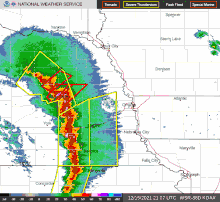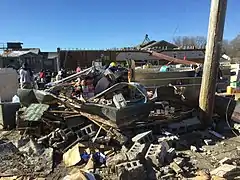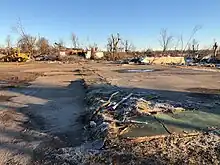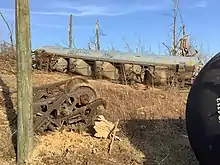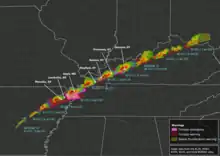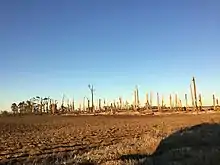The Tornadoes Portal
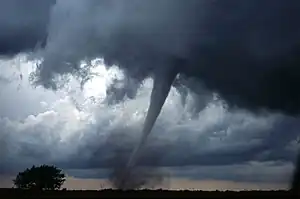
Selected tornado article -
Selected tornado list -
This page documents all tornadoes confirmed by various weather forecast offices of the National Weather Service in the United States in November 2017. Based on the 1991–2010 averaging period, 58 tornadoes occur across the United States throughout November while 24 more occur in December.
Despite only four days, producing tornadoes, November saw two outbreak days that produced over a dozen. However, the month was still well below average with 42 tornadoes. Tornado events in December were generally small and an also well below average 12 tornadoes were confirmed, which is half of the number of tornadoes typically seen during the month. (Full article...)Selected image -

Selected tornado year -
Related portals
Recent tornado outbreaks

Recent tornado outbreaks
July
- July 1
- A violent EF4 tornado hits Mountain View County, Alberta, Canada, becoming only the third EF4 tornado in the province's history. (Northern Tornadoes Project)
- July 12–13
- Several tornadoes occur in the Midwestern United States and Central Canada, including an EF1 tornado that passed through the suburbs of Chicago. (NWSChicago)
- July 16
- A rare EF1 tornado touches down in Aguada, Puerto Rico, significantly damaging two houses. (Iowa State University)
Tornado anniversaries
November 26
- 1887 – An F2 tornado destroyed barns and a dance hall on the edge of Mineola, Texas. Five people were killed, and 20 injured, when the walls of the dance hall collapsed.
November 27
- 1973 – A tornado outbreak hit parts of the Southeastern United States. Three tornadoes (one F2 and two F1) moved across DeSoto County, Mississippi and caused extensive damage in and around Horn Lake and Southaven, Mississippi, killing one person and injuring 75. In all, 212 mobile homes and two permanent homes were destroyed. An F3 tornado caused significant damage in Huntsville, Alabama, injuring 32 people. Planes and hangars were destroyed at the airport, and the National Weather Service office lost its roof.
- 1994 – An outbreak brought destructive tornadoes to Tennessee, Arkansas, and Mississippi. An F3 tornado destroyed 28 homes and damaged 300 others in Germantown, Tennessee, killing three people at a family reunion and injuring 25 others across town. Another F3 tornado caused major damage to 40-50 homes in Magee, Mississippi, where two people were killed by a falling tree. Yet another F3 tornado destroyed 27 homes in Chestnut Bluff and Crockett Mills, Tennessee, where it killed one person and injured three.
- 2005 – Two people were killed and 15 were injured in a tornado outbreak across Arkansas, Kansas, and Missouri. An F3 tornado overturned vehicles on Interstate 40 west of Plumerville, Arkansas, with one death and seven injuries in one vehicle. The other death was from an F2 tornado that destroyed a home near Briar, Missouri.
November 28
- 1941 – One of the deadliest tornadoes on record in Japan struck Toyohashi, Aichi Prefecture, killing 12 people and injuring 177, with 347 houses severely damage or destroyed.
- 1988 – Part of a small tornado outbreak, a long-track F4 tornado, which touched down after midnight, traveled 83 miles (134 km) across North Carolina, reaching peak intensity in Raleigh. Two people were killed and 105 people were injured in the Raleigh area, with two other deaths and 49 other injuries elsewhere along the track. In all, the tornado destroyed 476 homes and 78 businesses, with 2000 other homes damaged. Damage totaled $77.2 million (equivalent to $191 million in 2022).
Did you know…
- ...that the 2013 Moore tornado that struck Moore and Newcastle, Oklahoma, is the most recent EF5 tornado?
- ...that the 2021 South Moravia tornado, an IF4 tornado with winds between 207–260 mph (333–418 km/h), was the strongest tornado to hit the Czech Republic in modern history?
General images -
 Featured Article or List -
Featured Article or List -
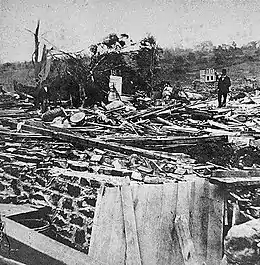
Although historically the U.S. state of Connecticut is not typically known to fall casualty to tornadoes, more than 100 of these powerful storms have affected the state in modern history, resulting in at least 48 deaths, 780 injuries, and more than $500 million in damage. This list of tornadoes in the state is likely incomplete, as official records date back only to 1950 for tornadoes in the United States.
As with most of the northeastern United States, the number of tornadoes peaks in the summer months, normally in July or August. Hartford County has had the most tornadoes in the state, although since 1950 Litchfield County has reported the most tornadoes. Several areas have been struck more than once, and Waterbury has been struck by no less than four tornadoes since 1955. (Full article...)List of Featured articles and lists |
|---|
Topics
Subcategories
Related WikiProjects
The scope of WikiProject Severe weather is to write articles about severe weather, namely thunderstorms and tornadoes. Their talk page is located here.
WikiProject Weather is the main hub for all articles that are weather-related. WikiProject Weather strives to improve articles in a variety of weather topics, including Tropical Cyclones, Severe Weather, General meteorology, Non-tropical Storms, Climate, Floods, Droughts and wildfires, Meteorological instruments and data, Meteorological Biographies, and Space Weather. If you would like to help, please visit the project talk page.
WikiProject Meteorology is a collaborative effort by dozens of Wikipedians to improve the quality of meteorology- and weather-related articles. If you would like to help, visit the project talk page, and see what needs doing. The project is currently being merged into WikiProject Weather.
WikiProject Tropical cyclones is a daughter project of WikiProject meteorology. The dozens of semi-active members and several full-time members focus on improving Wikipedia's coverage of tropical cyclones.
Wikipedia is a fully collaborative effort by volunteers. So if you see something you think you can improve, be bold and get to editing! We appreciate any help you can provide!
Things you can do
 |
Here are some tasks awaiting attention:
|
Wikimedia
The following Wikimedia Foundation sister projects provide more on this subject:
-
 Commons
Commons
Free media repository -
 Wikibooks
Wikibooks
Free textbooks and manuals -
 Wikidata
Wikidata
Free knowledge base -
 Wikinews
Wikinews
Free-content news -
 Wikiquote
Wikiquote
Collection of quotations -
 Wikisource
Wikisource
Free-content library -
 Wikiversity
Wikiversity
Free learning tools -
 Wikivoyage
Wikivoyage
Free travel guide -
 Wiktionary
Wiktionary
Dictionary and thesaurus
-
 List of all portalsList of all portals
List of all portalsList of all portals -
 The arts portal
The arts portal -
 Biography portal
Biography portal -
 Current events portal
Current events portal -
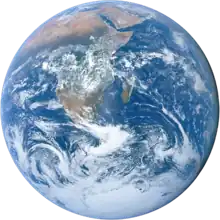 Geography portal
Geography portal -
 History portal
History portal -
 Mathematics portal
Mathematics portal -
 Science portal
Science portal -
 Society portal
Society portal -
 Technology portal
Technology portal -
 Random portalRandom portal
Random portalRandom portal -
 WikiProject PortalsWikiProject Portals
WikiProject PortalsWikiProject Portals


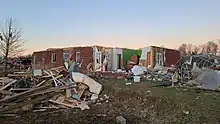
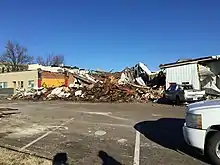
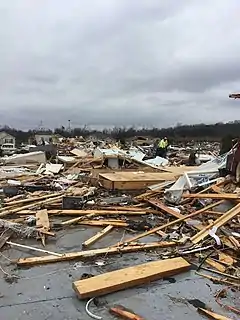
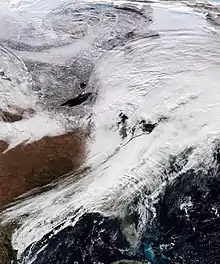
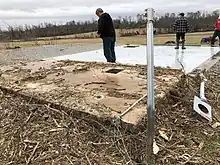

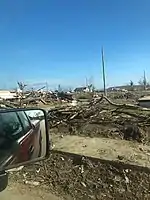
.jpg.webp)
